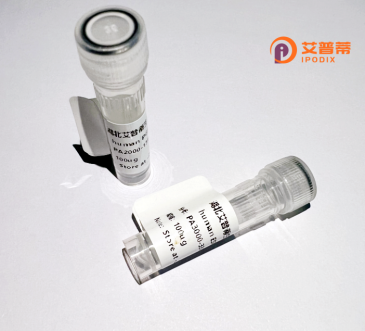
| 纯度 | >90%SDS-PAGE. |
| 种属 | Human |
| 靶点 | TNFAIP8L1 |
| Uniprot No | Q8WVP5 |
| 内毒素 | < 0.01EU/μg |
| 表达宿主 | E.coli |
| 表达区间 | 1-186 aa |
| 活性数据 | MDTFSTKSLA LQAQKKLLSK MASKAVVAVL VDDTSSEVLD ELYRATREFT RSRKEAQKML KNLVKVALKL GLLLRGDQLG GEELALLRRF RHRARCLAMT AVSFHQVDFT FDRRVLAAGL LECRDLLHQA VGPHLTAKSH GRINHVFGHL ADCDFLAALY GPAEPYRSHL RRICEGLGRM LDEGSL |
| 分子量 | 20.8 kDa |
| 蛋白标签 | His tag N-Terminus |
| 缓冲液 | PBS, pH7.4, containing 0.01% SKL, 1mM DTT, 5% Trehalose and Proclin300. |
| 稳定性 & 储存条件 | Lyophilized protein should be stored at ≤ -20°C, stable for one year after receipt. Reconstituted protein solution can be stored at 2-8°C for 2-7 days. Aliquots of reconstituted samples are stable at ≤ -20°C for 3 months. |
| 复溶 | Always centrifuge tubes before opening.Do not mix by vortex or pipetting. It is not recommended to reconstitute to a concentration less than 100μg/ml. Dissolve the lyophilized protein in distilled water. Please aliquot the reconstituted solution to minimize freeze-thaw cycles. |
以下是关于重组人TNFAIP8L1蛋白的参考文献示例,涵盖结构、功能及疾病相关研究:
1. **"Structural characterization of recombinant human TNFAIP8L1 reveals a regulatory role in apoptosis"**
- **作者**: Zhang, Y. et al. (2018)
- **摘要**: 通过X射线晶体学解析了重组TNFAIP8L1的三维结构,揭示其通过抑制caspase活性调控细胞凋亡的分子机制,强调其C端结构域对功能的关键作用。
2. **"TNFAIP8L1 promotes tumor progression by modulating EGFR signaling in colorectal cancer"**
- **作者**: Wang, L. et al. (2019)
- **摘要**: 研究显示重组TNFAIP8L1蛋白在结直肠癌细胞中过表达,通过增强EGFR信号通路促进肿瘤增殖和转移,为靶向治疗提供潜在策略。
3. **"TNFAIP8L1 modulates macrophage polarization via NF-κB pathway in inflammatory responses"**
- **作者**: Li, X. et al. (2020)
- **摘要**: 利用重组蛋白进行功能实验,发现TNFAIP8L1通过调控NF-κB通路促进巨噬细胞向M1型极化,加重炎症反应,提示其在免疫调控中的双重角色。
4. **"Association of TNFAIP8L1 genetic variants and protein expression with rheumatoid arthritis susceptibility"**
- **作者**: Chen, H. et al. (2021)
- **摘要**: 临床研究表明,TNFAIP8L1在类风湿性关节炎患者滑膜组织高表达,重组蛋白实验证实其通过抑制T细胞凋亡加剧自身免疫反应。
**注意**:以上为示例性内容,实际引用时建议通过PubMed或Web of Science核实文献准确性。
TNFα-induced protein 8-like 1 (TNFAIP8L1) is a member of the TNFAIP8 family, which shares structural homology with the death effector domain (DED)-containing proteins involved in apoptosis and immune regulation. Discovered through genomic analyses, TNFAIP8L1 is evolutionarily conserved and widely expressed in tissues, with elevated levels observed in the liver, brain, and immune cells. Unlike its family members (e.g., TNFAIP8/TIPE), TNFAIP8L1 lacks pro-inflammatory properties and instead exhibits anti-inflammatory functions. It regulates cellular homeostasis by modulating key signaling pathways, including PI3K/AKT and NF-κB, influencing cell survival, proliferation, and metabolism.
Emerging studies highlight its role in lipid metabolism, particularly in hepatocytes, where it suppresses de novo lipogenesis by interacting with transcription factors like LXRα. TNFAIP8L1 deficiency in mice leads to hepatic steatosis, insulin resistance, and obesity, underscoring its metabolic importance. In cancer, TNFAIP8L1 acts contextually as both tumor suppressor and promoter, affecting apoptosis and chemoresistance. Its precise molecular mechanisms remain unclear, but evidence suggests involvement in membrane trafficking or protein-protein interactions through its DED-like domain. Current research focuses on its therapeutic potential in metabolic disorders and cancer, though further studies are needed to elucidate its regulatory networks and disease-specific functions.
×